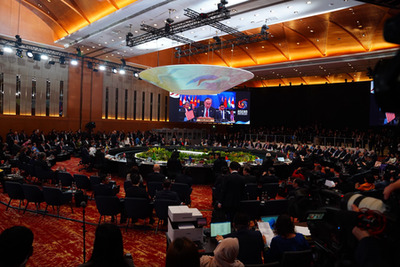Kuala Lumpur, Oct 28 (IANS) The participating countries of the East Asia Summit (EAS) have reaffirmed their collective resolve to strengthen disaster resilience across the region, calling for urgent action to fortify the ASEAN Community's capacity to withstand and recover from disasters.
The 20th East Asia Summit (EAS) convened under Malaysia's ASEAN Chairmanship on Monday in Kuala Lumpur. During this, the participating nations adopted a declaration, underscoring the growing complexity of global disaster risks, driven by environmental threats, rapid urbanisation, and socio-economic vulnerabilities.
Recognising the increasing frequency and intensity of disasters, the Summit recalled pivotal commitments such as the 2009 Cha-am Hua Hin Statement and the 2014 EAS Statement on Rapid Disaster Response, which emphasised regional cooperation in disaster preparedness, response, and recovery.
The leaders noted that anticipatory action, especially when localised, has proven "effective" in reducing disaster impacts. Localisation, involving active participation from local authorities, communities, organisations, and the private sector, was highlighted as a cornerstone of successful disaster management.
The leaders also recalled the localisation that has been highlighted in key frameworks and agreements, including the ASEAN Agreement on Disaster Management and Emergency Response (AADMER), ASEAN Declaration on One ASEAN, One Response: ASEAN Responding to Disasters as One in the Region and Outside the Region, ASEAN Framework on Anticipatory Action in Disaster Management, ASEAN Leaders' Declaration on Sustainable Resilience, the Sendai Framework for Disaster Risk Reduction 2015-2030, and the Co-Chairs' Summary of the Seventh session of the Global Platform for Disaster Risk Reduction (GPDRR), also known as the Bali Agenda for Resilience.
These documents collectively underscore the importance of community-led approaches and the integration of local wisdom and capacities in disaster risk reduction.
The Summit appreciated that localised anticipatory action can reduce physical, social, and economic vulnerabilities, offering targeted solutions tailored to specific hazards.
It acknowledged the need to empower local actors in disaster preparedness and response, ensuring their central role in building resilience and mitigating impacts. The declaration emphasised the development of science and technology-based, locally tailored, and regularly updated disaster risk assessments, hazard maps, and impact-based early warning systems as critical enablers of anticipatory approaches.
Recognising the value of risk-informed investment, the Summit affirmed that "prudent" planning and resource allocation can yield cost-effective and equitable solutions for long-term community resilience.
The participating countries declared their commitment to fulfilling regional and international obligations, including those outlined in AADMER, ASEAN SHIELD, and the Sendai Framework, while reinforcing the role of local communities in responsive disaster management.
The declaration called for strengthened regional collaboration through sharing best practices, capacity building, and resource mobilisation, facilitated by institutions such as the ASEAN Coordinating Centre for Humanitarian Assistance (AHA Centre).
It encouraged investment in local anticipatory action capacities, infrastructure, and early warning systems, integrating disaster risk reduction into post-disaster recovery and reconstruction efforts.
The countries also reaffirmed the commitment to "foster multi-stakeholder partnerships among EAS participating countries, enhancing cooperation with the ASEAN Committee on Disaster Management (ACDM) and the AHA Centre, the ASEAN Center for Climate Change (ACCC), the ASEAN Coordinating Center for Transboundary Haze Pollution Control (ACC THPC), local governments, the private sector, academia, the Red Cross and Red Crescent Movement, Non- Governmental Organisations (NGOs), and other relevant stakeholders to strengthen capacities and resources."
The Summit urged collaboration to enhance local early warning systems, mobile-based alerts, GIS-based community risk mapping, and AI-powered forecasting models for effective dissemination of early warning information.
The declaration further supported the active participation of local actors in regional and community-led disaster initiatives, capacity development, and implementation of contextually relevant anticipatory actions. It stressed leveraging local culture and wisdom, recognising communities as first responders and vital contributors to disaster risk reduction.
The Summit explored the development of national-level guidelines and mechanisms, including pre-arranged financing, to enable rapid decision-making and delivery of anticipatory actions at the local level.
It also advocated for the integration of localisation principles into national and regional disaster management frameworks, ensuring their effective implementation through EAS statements.
--IANS
sd/
You may also like

Maharashtra: Former minister Bacchu Kadu leads march to Nagpur over loan waiver for farmers

Bihar polls: Mahagathbandhan releases manifesto titled 'Bihar Ka Tejashwi Pran,' NDA calls it a "bunch of lies"

Harshvardhan Rane says he will sign his next with Milap Zaveri blindly

Dubai Ruler Sheikh Mohammed highlights holistic education as foundation for future UAE leaders

Bihar: Grand Alliance manifesto cover sparks debate over low Muslim representation







